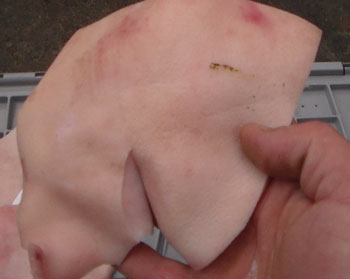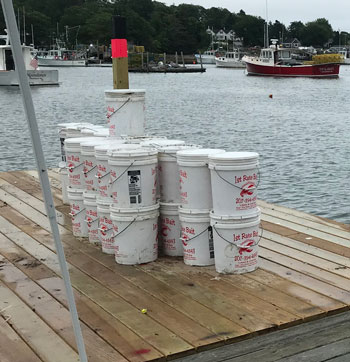Hide Bait May Go Beyond An
Alternate Niche
by Mike Crowe

Typical piece of pig hide bait. The hide is salted to preserve it. The pieces remain pliable and can be easily cut with a knife.
The lobster stock in the Gulf of Maine appears to be in good shape. Landings have grown rapidly over the last 30 years as well as the demand for bait. Good quality affordable lobster bait is an important component of profitability.
Atlantic herring is available and it’s the bait of choice. Some fishermen prefer pogies, redfish and alewives, but these are not as dependable. So called alternative baits - cow hide, pig hide, the composite puck, pellets - have been around for a few decades. Variables in a key component like bait can be particularly difficult, whether it’s price, quality or supply stability.
“A few years ago cow hide was popular, but it’s not used here in Corea now. Other kinds of artificial baits have been tried here, but none of them took off”, said Warren Polk at the Corea Coop.
“You have had other baits, but none were as popular as pig hide is now.”
Polk said fishermen liked that, “ the pig hide bait is handy to use and it comes in 5-gallon re-closable buckets. The other hide baits need special containers with scents and they are more time-consuming.”
“No one brags when
it’s good and everyone
complains when it’s not.”
– Steve Peobody,
Beals Jonesport Coop
“I’m at a point now with the use of pig hide bait that it could be used exclusively for lobster bait. Pig hide is a good supplemental bait now”, said Loren Faulkingham of Jonesport. “Right now I am debating if I will use it exclusively”. Faulkingham said he has conducted experiments to compare the results of herring bait to pig hide bait. In one he set two trawls, one with a mix of herring bait and pig hide bait and the other trawl with only pig hide bait. Both sets fished equally as well, he said. “It is easy to use and there is less labor. A plus is when you accomplish more with less”, said Faulkingham. He said he would like to be able to use pig hide exclusively. “If there is a herring shortage the price will go up”, he said.
Bob Ingalls of Bucks Harbor, said, “I started using pig hide in 2016. Before that I used cow hide for 5 or 6 years. When I started with pig hide I used cow hide in some traps, now I use pig hide in all my traps. After they were required to remove the hair from cow hide, it didn’t work as good. I fish well off the 3-mile line. Guys out there are using pig hide.”
Bruce Worcester of Prospect, Maine said has been in the alternative bait business for 45 years. He has sold pig, moose and other hide baits, but now sells only cow hide bait. When he was fishing lobster in the 1990s and first tried cow hide bait, other fishermen would laugh, Worcester said. When he started selling cow hide bait in Maine the younger fishermen were willing to try it, but the older fishermen were resistant. He gradually built a customer base, went to other New England states and now sells cow hide bait from Maine to Florida, the Caribbean and to the west coast dungeness crab fleet.

Pig hide bait buckets stacked on a wharf in Friendship, Maine. Each bucket weighs 40 lbs. and contains 80 to 90 pieces of bait. The buckets are returnable. Photos courtesy 1st Rate Bait.
About 15 years ago, after complaints from consumers, Maine required the removal of hair from hide baits. “The other New England states are OK with hair on cow hide bait”, said Worcester. He got out of pig hide bait when the state of Maine intervened, suspending its use while writing a regulation.
The changes in lobster landings, the rising demand for bait and the federal regulatory response to Atlantic herring stock assessments has fostered an interest in alternative lobster bait. Bessy Bait in New Hampshire sells cow hide bait. They said sales are down a little right now, but they expect them to be higher next year when the herring cuts begin.
Steve Peabody runs the Beals Jonesport Fishermen’s Coop. “Pig Hide? We sell tons of it”, said Peabody. “For 7 or 8 years the coop sold cow hide bait. Pig hide started slow. Three or four buckets at a time. Right now we have 17 pallets with 36 buckets on a pallet. A lot of guys mix the pig hide with herring.” As far as fishermen’s comments on how it works for them, Peabody said, “It’s like a lot of things with fishing. No one brags when it’s good and everyone complains when it’s not”.
There are a couple of people producing and marketing pig hide downeast. Peabody said, “I buy 1st Rate Bait. They have refined it into a good product.”
Fishermen and bait dealers referred to pending herring shortages in 2019. Some dealers were confident that other bait fish like redfish, pogies, fish racks, skate and others would be available to make up for the herring cuts. Chris Beyers at DC Air in Gouldsboro said, “We have hide bait here, but we don’t sell a lot of it. We’re not worried about having enough (fish) bait.” But certainty of quantity and the kind is not widely assured.
In the 1990s (Worcester)
first tried cow hide bait,
other fishermen
would laugh.
– Bruce Worcester
One bait dealer said they were “not sure it was a good idea to be putting non-marine animal parts in the ocean”. The Maine DMR lists on its website the marine and fresh water species that are allowed to be used as bait. The concern is the introduction of “exotic pathogens” from non-native species. Hide baits are not evaluated based on pathogen concerns by the DMR. The DMR requires that everything in a bait container be listed on the container’s label.
Maine Bait Law: http://legislature.maine.gov/legis/statutes/12/title12sec6432-A.html
Matt McDonald of 1st Rate Bait in Alton, Maine said he spent 10 years developing a pig hide bait. He saw a need based on what he read in newspapers, the amount of fish being taken for bait and the need Maine fishermen had for bait. “In those 10 years” he said. “I had to learn what fishermen expected in a bait. I had to know how they used it. What they didn’t like about the bait they were using, used to use or would prefer to use.” Herring, pogies and other bait fish are handled the way they are because they have to be. They are perishable and change quickly after they are caught.
McDonald said, “When I started I couldn’t give pig hide bait away. Fishermen were reluctant to try something that different.” The controversy in Maine about hair on cow hide bait was lingering back then. McDonald said he continuously improved the product to meet the demands lobstermen had for bait and “to exceed them”, he said. He said his research efforts and engagement with the legal process, led to the Maine legislature making pig hide bait, with specifications regarding hair removal and thickness, a legal alternative bait source in Maine when L.D. 1207 was signed into law in June 2017. Chapter 25.12 Alternative bait labeling (maine.gov or link here.)
Many lobstermen prefer the seasonally available pogie (menhaden) for lobster bait. The oil from the pogie drifts in the current and attracts lobster. McDonald said, “The oil in pig hide bait serves the same function as the oil in pogies. We have developed a way, without chemicals, to control the continuous release of the oil in the pig hide that attracts lobster”.
You might get two or
three hauls with
the same bait.
– Lewis Bishop, Lamoine
Lobsterman Lewis Bishop of Lamoine uses McDonald’s bait and described it as being like the fat in salt pork. “It’s flexible, clean and comes in pieces that fit in a large bait bag, or can be strung. It is pliable. You can’t push your finger through it, but it can be easily cut with a knife.” Bishop said he used to use cow hide bait. “But after they had to remove the hair, it changed the texture and it didn’t work as well”. He started mixing pig hide bait with herring and for a few years he was using pig hide exclusively.
Bishop said, “Every lot of fish bait can be different. That inconsistency made it more difficult to know why traps were not catching lobster, if they weren’t”. He is currently back to mixing herring with pig hide because, he said, “it seemed like it was what lobster wanted.” “Every fisherman has a different opinion, but with pig hide the trap can set longer, the price is consistent, every bucket is the same and and you might get two or three hauls with the same bait”, Bishop said. Fishermen, bait dealers and McDonald acknowledged that many things in the water can influence how long any bait lasts.
The lobster industry will continue to need bait. Bait dealers will try to find ways to supply that bait, whether it’s Atlantic herring, seasonal fish options, frozen fish, other marine options allowed by regulations or approved non marine baits. Supply, demand and tradeoffs, as they usually are, will be the arbiters.
